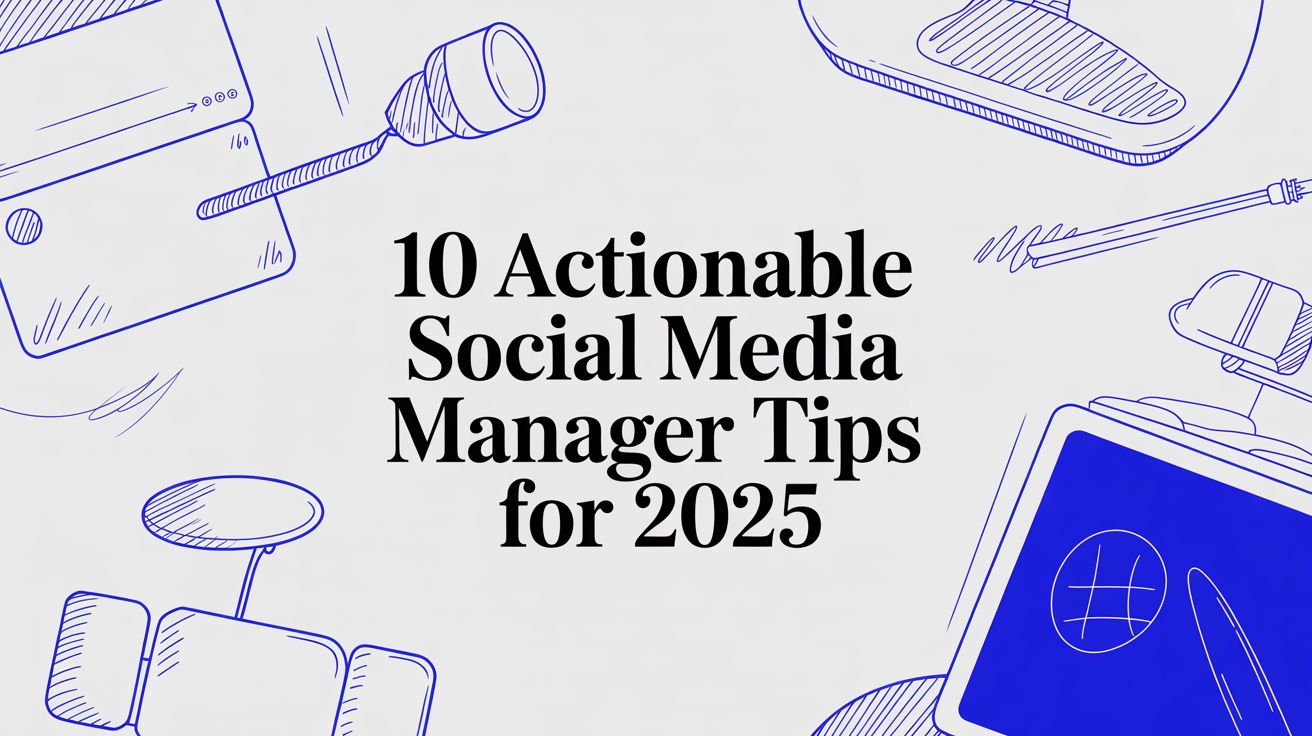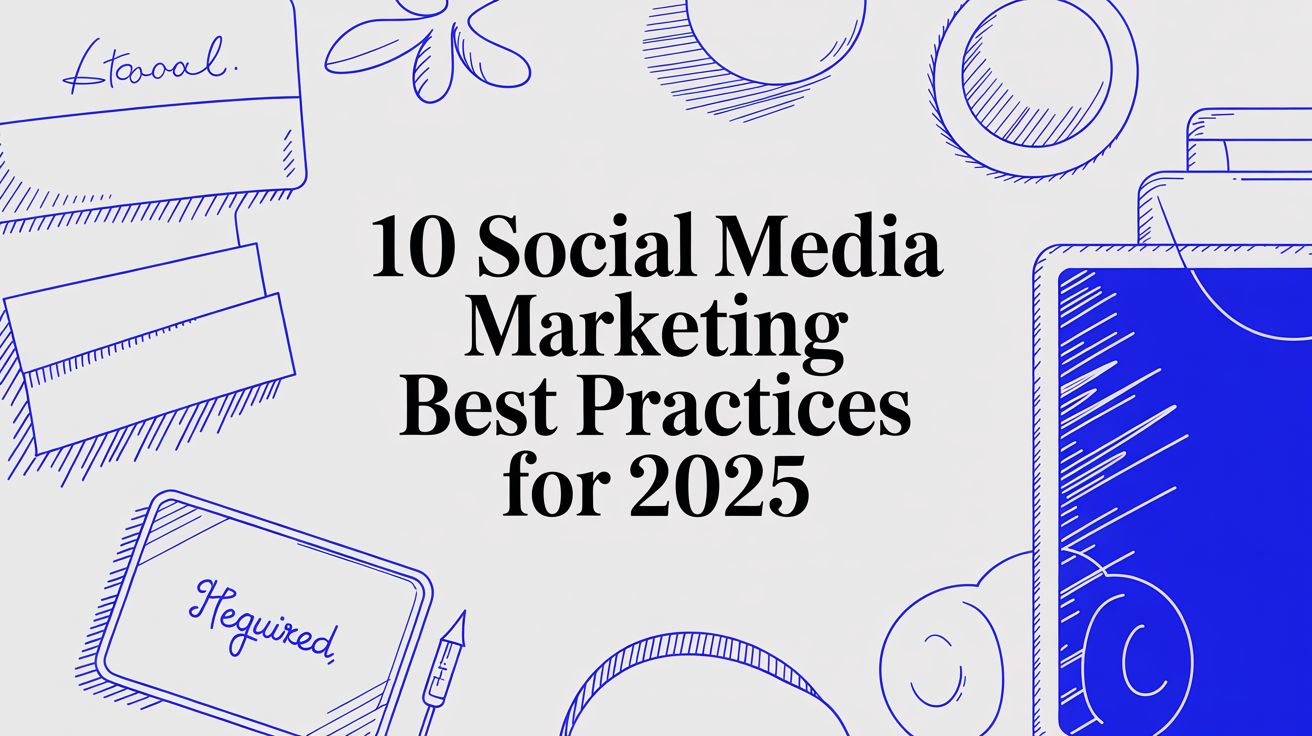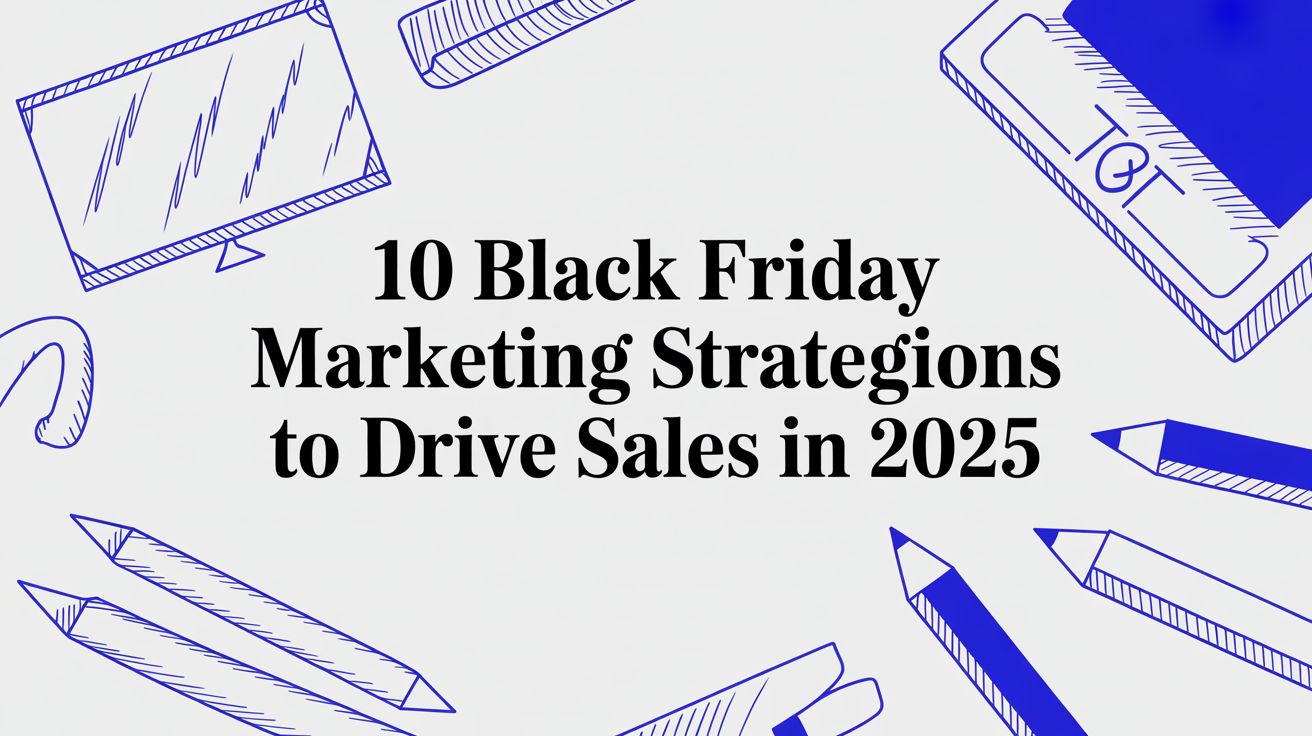10 Actionable Social Media Manager Tips for 2025
Unlock your potential with these 10 expert social media manager tips. Learn actionable strategies for engagement, content, and analytics to elevate your brand.

In the fast-paced world of social media, managing a brand's presence requires more than just posting updates. It's a strategic blend of art and science, demanding creativity, analytical prowess, and a deep understanding of digital communities. As platforms evolve and algorithms shift, the role of a social media manager becomes increasingly complex and vital. This guide provides 10 powerful, actionable social media manager tips designed to move beyond surface-level metrics and help you build a robust, engaging, and high-performing strategy.
We'll explore everything from workflow optimization to creating genuine community connections, equipping you with the tools and insights needed to thrive. Mastering these skills is not just about keeping up; it's about leading the conversation and driving measurable results. To truly thrive in the evolving digital space, a social media manager should always refer to the top social media marketing best practices for 2025.
This listicle cuts through the noise to offer specific, practical advice you can implement immediately. Whether you're refining your content calendar, measuring ROI, or leveraging user-generated content, each point is designed to enhance your effectiveness and elevate your brand's digital footprint. Let's dive into the strategies that will define social media success.
1. Create a Content Calendar and Plan Ahead
One of the most foundational social media manager tips is to move from reactive posting to a proactive, strategic approach. A content calendar is your roadmap for this, allowing you to organize, schedule, and align all social media activities with overarching business goals. Instead of scrambling for daily content, you can plan weeks or even months in advance, ensuring a consistent brand voice and a steady stream of valuable posts. This foresight prevents content gaps and empowers you to build cohesive campaigns rather than disconnected one-off posts.

Major brands like Coca-Cola plan seasonal campaigns three months ahead, while HubSpot advocates for a 4-week planning cycle to remain agile. This structured planning allows for better resource allocation, cross-team collaboration, and a more polished final output.
How to Implement a Content Calendar
Start by choosing a tool that fits your workflow. Simple options like Google Sheets are effective, while dedicated platforms like Asana, Monday.com, or Hootsuite offer advanced features.
- Adopt a Content Mix: A balanced calendar prevents audience fatigue. A good starting point is the 60/20/20 rule: 60% core content (educational, entertaining), 20% promotional, and 20% community engagement.
- Schedule for Peak Times: Use your platform analytics to identify when your audience is most active and schedule your posts for maximum visibility.
- Leave Room for Spontaneity: Plan your core content but leave a few "buffer" slots each week. This allows you to jump on relevant trends or share real-time company news without derailing your entire schedule.
- Integrate Campaign Timelines: When planning a major event or launch, use your calendar to map out every promotional touchpoint, including countdowns. For effective timelines, explore how to promote an event on Facebook with countdowns.
2. Know Your Audience and Create Buyer Personas
One of the most critical social media manager tips is to stop creating content for a generic crowd and start speaking directly to your ideal customer. Understanding your audience’s demographics, interests, and pain points is the foundation of a successful strategy. Buyer personas, semi-fictional representations of your target customers, transform raw data into relatable human profiles that guide every content decision you make.

For instance, Nike’s social content varies significantly depending on whether they are targeting a professional athlete, a weekend fitness enthusiast, or a fashion-conscious consumer. Similarly, beauty brand Glossier focuses its messaging on the self-expression journey of its core 18-35 year old persona. This deep audience knowledge ensures that content resonates, builds community, and drives conversions.
How to Implement Buyer Personas
The goal is to create 3-5 detailed personas that represent the key segments of your audience. A critical step is to understand how to create buyer personas that accurately reflect your target audience.
- Gather Data: Dive into your social media and website analytics (like Google Analytics) to uncover demographic information. Supplement this with surveys and interviews with your best existing customers to gather qualitative insights.
- Flesh Out the Details: Give each persona a name, a backstory, goals, and challenges. What social platforms do they use? What content formats do they prefer? What motivates them to make a purchase?
- Socialize and Align: Share these detailed personas across your marketing, sales, and customer service teams. This ensures everyone is working with the same customer vision, creating a cohesive brand experience.
- Review and Refine: Audiences evolve, so your personas should too. Revisit and update them every quarter based on new performance data and customer feedback to keep your strategy sharp and relevant.
3. Optimize Posting Times Based on Audience Activity
One of the most impactful social media manager tips involves not just what you post, but when you post it. Publishing content when your audience is most active dramatically increases its initial visibility and engagement potential. The algorithms on platforms like Instagram and Facebook prioritize content that gets early traction, meaning a well-timed post is more likely to be shown to a wider audience, boosting its organic reach without any additional ad spend.
Posting at 2 PM on a Tuesday might be ineffective if your audience is primarily engaged at 8 PM. General best practices provide a starting point, for instance, LinkedIn often sees peak business-hour engagement, while TikTok's best windows are typically early morning and late evening. However, your specific audience’s behavior is what truly matters.
How to Implement Optimal Timing
Start by digging into the native analytics on each social media platform. These tools provide demographic data and, crucially, charts showing the days and hours your followers are most often online.
- Analyze Your Data: Use tools like Instagram Insights or Facebook Page Insights to find your unique peak hours. Don't rely on generic industry stats; your audience is unique.
- Test and Measure: Dedicate a 4-6 week period to testing different time slots. Post the same type of content at various times on different days and track which posts receive the highest engagement (likes, comments, shares) within the first few hours.
- Consider Time Zones: If your audience is global or spread across different time zones, identify the largest segments and schedule key posts to align with their peak times, or post multiple times to cover different regions.
- Automate with Schedulers: Use social media scheduling tools to automatically publish your content at these pre-determined optimal times. This ensures consistency even when you are not actively online.
4. Use Data Analytics to Measure Performance and ROI
Effective social media management is not about guesswork; it is about making informed decisions backed by data. One of the most critical social media manager tips is to consistently track key performance indicators (KPIs) to demonstrate value, identify what works, and optimize your strategy. Analytics reveal vital information about engagement patterns, audience growth, conversion data, and content performance, transforming raw numbers into a clear roadmap for success.

Brands like Nike use analytics to optimize ad spend across platforms, while Starbucks tracks Instagram engagement by location to tailor local content. Utilizing platforms like Hootsuite or Sprout Social allows you to measure metrics that prove the direct impact of your efforts on business goals, justifying your strategy and budget.
How to Implement Data Analytics
Start by defining what success looks like for your brand and connecting social media metrics to those broader business objectives. This ensures you are tracking data that genuinely matters.
- Define Clear KPIs: Align your metrics with business goals. If your goal is brand awareness, track reach and impressions. If it is driving sales, focus on click-through rates and conversions.
- Use UTM Parameters: To accurately measure ROI, append UTM parameters to links you share on social media. This allows you to track exactly how much traffic and revenue is generated from each platform in Google Analytics.
- Create Regular Reports: Generate monthly or quarterly performance reports to showcase progress, identify trends, and highlight wins. Compare performance week-over-week and month-over-month to spot patterns.
- Benchmark Your Performance: Context is key. Compare your metrics against industry standards and your own historical performance to understand if your strategy is effective and where there is room for improvement.
5. Create Engaging, Platform-Specific Content
One of the most impactful social media manager tips is to abandon the "one-size-fits-all" approach to content. Each social platform has a unique audience, algorithm, and set of content formats that perform best. Creating platform-native content means tailoring your message to fit the environment, which significantly boosts engagement and resonance. Instead of simply cross-posting the same image and caption, you adapt your creative to leverage platform-specific features like Instagram Reels, LinkedIn articles, or TikTok trends.
A brand like Nike excels at this by using high-energy, inspirational Reels on Instagram to capture a younger audience, while on LinkedIn, they share corporate responsibility stories and thought leadership content. This platform-specific strategy ensures their message is always relevant to the audience consuming it, maximizing the impact of every post.
How to Implement Platform-Specific Content
Begin by auditing your current channels and identifying the primary content formats for each. Use analytics to see what your audience already responds to and lean into those strengths.
- Master Short-Form Video: Dedicate resources to creating unique content for TikTok, Instagram Reels, and YouTube Shorts. These formats thrive on authenticity, trending audio, and quick, engaging edits.
- Leverage LinkedIn for Professional Value: Use LinkedIn to publish long-form articles, share industry insights, and post professional infographics. This is the ideal platform to build thought leadership and B2B credibility.
- Use Twitter for Timely Conversations: Focus on short, witty, and timely text-based posts. Engage in relevant conversations, use trending hashtags, and ask questions to spark immediate dialogue with your community.
- Optimize for Visual Discovery on Pinterest: Create high-quality, vertical graphics and videos (Idea Pins). Write detailed, keyword-rich descriptions to ensure your content is discoverable through search, driving traffic back to your website.
6. Build Community Through Active Engagement
One of the most powerful social media manager tips is to remember that these platforms are inherently social. Effective management isn't just about broadcasting content; it's about fostering genuine two-way conversations. By actively engaging with followers through comments, replies, and messages, you transform a passive audience into a loyal community. This community becomes your brand's biggest advocate, boosting organic reach and creating lasting loyalty.
Brands like Wendy's have built an entire persona around witty Twitter interactions, while GoPro thrives by featuring customer-generated content and celebrating its users. This approach shows that you value your audience's input and presence, making them feel seen and appreciated. Building a community is a long-term strategy that pays dividends in brand trust and engagement.
How to Implement Active Community Engagement
Start by shifting your mindset from content publisher to conversation facilitator. Dedicate specific times each day to interact with your audience, making engagement a core part of your workflow.
- Be Responsive and Timely: Aim to respond to comments and questions within a few hours during business hours. Quick replies show your audience that you are listening and actively present.
- Ask Open-Ended Questions: Instead of just posting statements, ask questions in your captions to encourage comments and spark discussions. Use interactive features like polls and quizzes in Stories to make participation easy.
- Highlight User-Generated Content (UGC): Regularly feature photos, videos, or testimonials from your followers (with permission). This not only provides you with authentic content but also makes your community members feel valued.
- Use Social Listening: Monitor brand mentions and relevant keywords to find and join conversations happening outside of your direct posts. This proactive engagement can attract new followers.
- Set the Tone: Create clear community guidelines and ensure anyone managing the account understands the brand's voice. Consistency is key to building a recognizable and trusted personality.
7. Leverage User-Generated Content and Influencer Partnerships
One of the most powerful social media manager tips is to let your audience become your brand advocate. User-generated content (UGC) and influencer collaborations build authenticity, provide powerful social proof, and extend your reach far beyond your own followers. This strategy involves encouraging customers to create content featuring your brand and partnering with relevant creators to tap into their loyal audiences. Instead of you telling everyone how great your product is, your satisfied customers and trusted influencers do it for you.
Brands like GoPro have built their entire marketing strategy on thrilling customer videos, while Starbucks' annual #RedCupContest generates millions of user-submitted photos each holiday season. These campaigns foster a sense of community and create a vast library of authentic marketing assets at a minimal cost.
How to Implement UGC and Influencer Marketing
Start by creating a system to encourage, collect, and share content from your community and partners.
- Create a Branded Hashtag: Establish a clear, unique hashtag for customers to use when sharing their experiences. This organizes all UGC in one place for easy discovery and resharing.
- Incentivize Participation: Run contests or offer features on your page to motivate users to create and share high-quality content. A simple shout-out can be a powerful motivator.
- Partner with Micro-Influencers: Collaborate with influencers who have 10,000 to 100,000 followers. They often have higher engagement rates and a more authentic connection with their audience than larger celebrities.
- Define Clear Expectations: Whether working with an influencer or running a UGC campaign, provide clear guidelines, deliverables, and timelines to ensure the content aligns with your brand values and goals. Always credit the original creator when you repost.
8. Stay Current With Platform Trends and Algorithm Changes
The social media landscape is in a constant state of flux, with platforms continuously rolling out new features and algorithm updates. A critical social media manager tip is to remain vigilant and adaptable. Staying informed about these changes allows you to pivot your strategy, leverage new features before they become saturated, and maintain your content's visibility and relevance. Ignoring these shifts can lead to decreased reach, engagement, and overall performance.
Proactive adaptation gives you a significant competitive advantage. For example, when Instagram launched Reels, early adopters saw a massive boost in organic reach as the platform prioritized its new feature. Similarly, LinkedIn's algorithm has shifted multiple times to favor different content types, rewarding managers who adjusted their approach to align with the latest preferences.
How to Stay Updated and Adapt
Building a habit of continuous learning is key to navigating the ever-changing digital environment. Integrate these practices into your regular workflow to stay ahead of the curve.
- Follow Official Sources: The most reliable information comes directly from the platforms. Follow the official business blogs and newsrooms for Meta, X (formerly Twitter), LinkedIn, TikTok, and Pinterest.
- Join Industry Communities: Participate in dedicated social media manager communities on Reddit (like r/socialmedia) or Facebook Groups. These forums are excellent for real-time discussions on new algorithm behaviors.
- Subscribe to Newsletters: Sign up for industry publications like Social Media Today or the Hootsuite Blog. They provide curated news, analysis, and insights directly to your inbox.
- Test New Features Quickly: When a new feature like Twitter Spaces or Instagram Threads launches, aim to experiment with it within the first two weeks. Early adoption often comes with an algorithmic boost and valuable learning opportunities.
9. Develop a Consistent Brand Voice and Visual Identity
One of the most powerful social media manager tips for building an iconic brand is to ensure absolute consistency. A unified brand voice and visual identity across all channels fosters recognition, builds trust, and signals professionalism. When your audience knows what to expect, they feel more connected and are more likely to engage. This means your tone, messaging, visuals, and values remain coherent whether a user sees you on Instagram, LinkedIn, or TikTok.
Brands like Wendy's have mastered this with their witty, irreverent voice, while Apple maintains a minimalist visual style and focused messaging everywhere. This consistency makes them instantly recognizable and reinforces their brand persona with every post, turning casual followers into loyal advocates.
How to Implement Brand Consistency
Start by creating a comprehensive brand guidelines document that can be shared with anyone creating content. This document is your single source of truth for all communications.
- Define Your Brand Personality: Choose 3-5 core adjectives that describe your brand (e.g., "empowering," "playful," "authoritative"). Use these to guide your tone and word choices.
- Establish Visual Rules: Create templates for different types of content. Specify your brand's color palette (hex codes), approved fonts, logo usage, and photography style to ensure a cohesive look.
- Document Your Voice: Outline specific rules for your brand's language. Include approved terminology, banned words, and even guidelines for using emojis and punctuation.
- Conduct Regular Audits: Once a month, review your social media profiles to check for inconsistencies. Ensure that all posts, from major announcements to simple replies, align with your established guidelines.
10. Implement Social Media Advertising Strategically
With organic reach declining across major platforms, paid social advertising is no longer optional; it's an essential component of a successful strategy. Strategic ads allow you to cut through the noise, reach highly specific audiences, and drive measurable business outcomes. Unlike organic posts, paid campaigns offer precise targeting capabilities that ensure your content is seen by users most likely to convert, complementing your organic efforts and maximizing your ROI.
Warby Parker built its brand by using lookalike audiences to find new customers, while Duolingo’s viral ad campaigns consistently achieve high engagement with a low cost per acquisition. These examples show that a well-defined ad strategy can accelerate growth and deliver tangible results that organic content alone cannot.
How to Implement Strategic Social Ads
Start by defining a clear objective, whether it's lead generation, sales, or brand awareness. This goal will dictate your campaign setup, creative, and key performance indicators.
- Segment Your Audiences: Go beyond basic demographics. Create custom and lookalike audiences based on website visitors, email lists, or users who have engaged with your content. Test 3-5 distinct audience segments before scaling your budget.
- A/B Test Everything: Continuously test different ad creatives, headlines, and calls to action. Even small changes can significantly impact performance. Refresh your ad creative every two weeks to combat audience fatigue.
- Track the Full Funnel: Install tracking pixels like the Meta Pixel or TikTok Pixel to monitor user actions from the initial click to the final conversion. Closely watch your cost per acquisition (CPA) to ensure profitability.
- Incorporate Urgency: Use dynamic elements in your ads to drive immediate action. For instance, you can use a countdown timer for your ads to promote limited-time offers or event registrations, creating a powerful sense of FOMO.
10-Point Comparison of Social Media Manager Tips
| Strategy / Complexity 🔄 | Resources / Efficiency ⚡ | Expected Outcomes 📊 | Ideal Use Cases 💡 | Key Advantages ⭐ | |---|---|---|---|---| | Create a Content Calendar and Plan Ahead | Moderate upfront planning; recurring maintenance | Consistent posting; aligned campaigns | Multi-platform campaigns; team coordination | Predictability; coordinated content | | Know Your Audience and Create Buyer Personas | High research and ongoing refinement | Higher relevance; improved conversions | Targeted campaigns; product-market fit | Reduced wasted effort; focused messaging | | Optimize Posting Times Based on Audience Activity | Low–medium testing and adjustment | Increased reach and engagement | Time-sensitive posts; limited teams | Better organic visibility; efficient timing | | Use Data Analytics to Measure Performance and ROI | High complexity; attribution challenges | Measurable ROI; rapid optimization | Performance-driven accounts; scaling | Data-driven decisions; KPI clarity | | Create Engaging, Platform-Specific Content | High creative complexity; format variety | Higher engagement and retention | Brand-building; audience growth | Strong algorithm performance; relevance | | Build Community Through Active Engagement | High ongoing moderation and response | Increased loyalty; organic reach growth | Customer-centric brands; service industries | Authentic connections; customer insights | | Leverage User-Generated Content and Influencer Partnerships | Medium coordination and vetting effort | Extended reach; increased authenticity | Awareness campaigns; product launches | Social proof; lower content costs | | Stay Current With Platform Trends and Algorithm Changes | Medium continuous learning and testing | Early feature advantage; maintained relevance | Fast-moving platforms; competitive markets | Early-adopter edge; future-proofing | | Develop a Consistent Brand Voice and Visual Identity | Medium–high documentation and training | Strong recognition; increased trust | Multi-channel brands; agencies | Cohesive identity; streamlined decisions | | Implement Social Media Advertising Strategically | High setup and optimization effort | Scalable reach; measurable conversions | Acquisition campaigns; rapid scaling | Precise targeting; quick scaling potential |
Putting Your Social Media Strategy into Action
The journey to becoming a highly effective social media manager is not a sprint; it is a marathon of continuous learning, strategic adaptation, and creative execution. The tips outlined in this article provide a comprehensive roadmap, guiding you from foundational planning to advanced strategic implementation. By embracing these principles, you can elevate your role from simply posting content to architecting a thriving digital community that drives tangible business results.
Key Pillars of Social Media Mastery
Let's distill the core takeaways. True success in this dynamic field rests on a few critical pillars. First is proactive planning, which involves creating detailed content calendars and developing rich buyer personas. This foundational work ensures your efforts are always aligned with your audience's needs and your brand's goals.
Second, a commitment to being data-driven is non-negotiable. Regularly diving into your analytics to measure performance, optimize posting times, and calculate ROI is what separates amateur efforts from professional, high-impact strategies. This analytical rigor informs every decision you make, from content creation to ad spend.
Finally, authentic engagement is the lifeblood of any successful social media presence. This means building a genuine community, fostering conversations, and creating platform-specific content that resonates deeply. It’s about being human, responsive, and consistent in both your brand voice and visual identity.
Your Actionable Next Steps
Mastering these social media manager tips requires turning knowledge into action. Here is how you can start today:
- Conduct a Full Audit: Review your current social media channels against the tips discussed. Where are the gaps? Identify 2-3 specific areas for immediate improvement, whether it's refining your brand voice or setting up more detailed analytics tracking.
- Refresh Your Content Strategy: Use the insights on audience personas and platform-specific content to overhaul your next month’s content calendar. Brainstorm fresh ideas that prioritize engagement and value over simple promotion.
- Experiment and Test: Choose one new tactic to implement this week. It could be launching your first strategic ad campaign, partnering with a micro-influencer, or experimenting with a new content format like Instagram Reels or TikTok videos. Document the results and learn from them.
Ultimately, the most successful social media managers are those who remain curious, adaptable, and persistent. The digital landscape will always evolve, but a strategy built on deep audience understanding, data-informed decisions, and genuine community building will always stand the test of time. By consistently applying these principles, you will not only achieve your marketing objectives but also build a powerful, lasting connection between your brand and its audience.
Ready to supercharge your promotional campaigns and create powerful urgency? A key social media manager tip is to build anticipation for your launches, sales, and events. With the Countdown Timer App, you can easily add dynamic, auto-updating countdowns directly to your Facebook Page or website to drive engagement and boost conversions. Explore how it works and start your free trial at Countdown Timer App today






